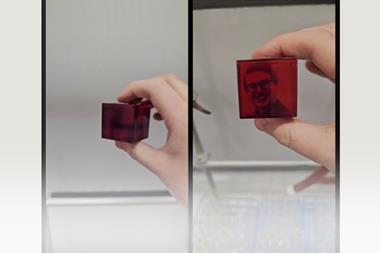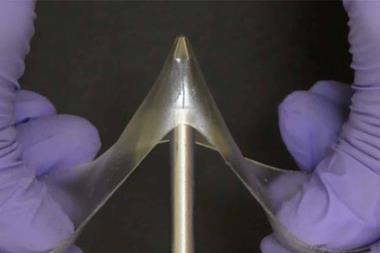A hydrogel–fabric composite that can support a load almost three times greater than the fabric alone has been made by scientists in Japan and the US.
For many applications, an ongoing challenge is to develop materials with seemingly contradictory properties. For example, the biomedical field wants materials that are tough, yet soft, wet, flexible and biocompatible – quite a tall order. Many researchers have spotted the potential of hydrogels, which are known for being soft and biocompatible, but limited by their lack of strength.
‘The current interest is to develop hydrogel-based materials that are flexible in bending and stiff in stretching,’ says Jian Ping Gong from the Hokkaido University. Gong’s group want to make synthetic materials with similar properties to biological ligaments – tough with the ability to load-bear, but also soft and bendy.
Natural ligaments incorporate collagen fibres within a gel matrix. But mimicking this approach with fibres and hydrogels is not without its challenges: ‘Conventional hydrogels usually have weak adsorption in the solid phase due to extensive swelling in water after preparation,’ explains Gong.
In this new study, Gong, together with Alfred Crosby from the University of Massachusetts, US, and their co-workers, modified the fibre-reinforced hydrogel design by combining a tough glass fibre fabric with a polyampholyte hydrogel. They found their formula had a synergistic effect; the mechanical properties of the hydrogel–fabric composite far outperformed the individual components. The fracture energy of the composite is 250,000J/m2 – much higher than the fabric alone (75,000J/m2) or existing fibre-reinforced hydrogels (4,000–30,000J/m2).
Hydrogel choice is key. Polyampholyte gels are made from equal amounts of oppositely charged monomers. And unlike typical hydrogels, which swell in water, polyampholyte gels shrink. When making the composite, ionic bonds form between hydrogel monomers to trigger the de-swelling. This action enhances adhesion between the gel and the fibres, anchoring the fibres closer together and thus makes the fabric stronger, tougher, and less likely to tear. Importantly, the fabric still retains a high water content.
‘It’s easy to make a material tough; it’s not as easy to make it tough with a lot of water in it,’ says Kenneth Shull, a polymer scientist at Northwestern University in the US.
Shull also comments that the research brings up some interesting issues. ‘Friction is really important for the toughness of a fabric and this work moves the field forward by considering the friction between the fibres and how the matrix gel actually mediates that.’
The team hope their work will spark a new generation of mechanically robust composites for potential applications in prosthetics, tear-resistant gloves and bulletproof vests.
References
This article is open access. Download it here:
D R King et al, Mater. Horiz., 2015, DOI: 10.1039/c5mh00127g






















No comments yet